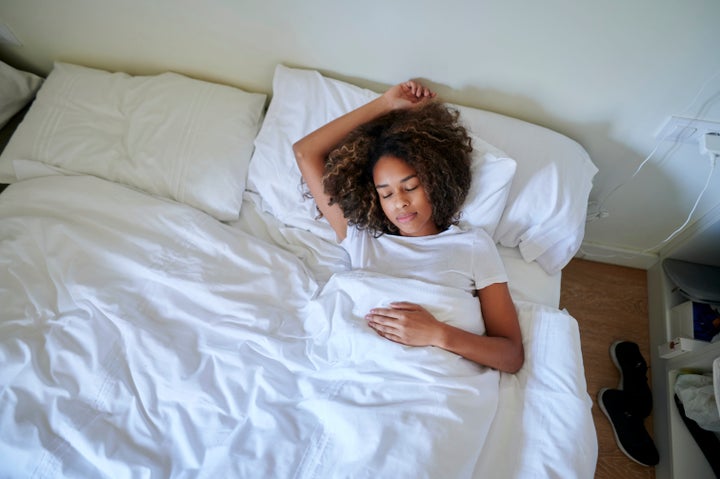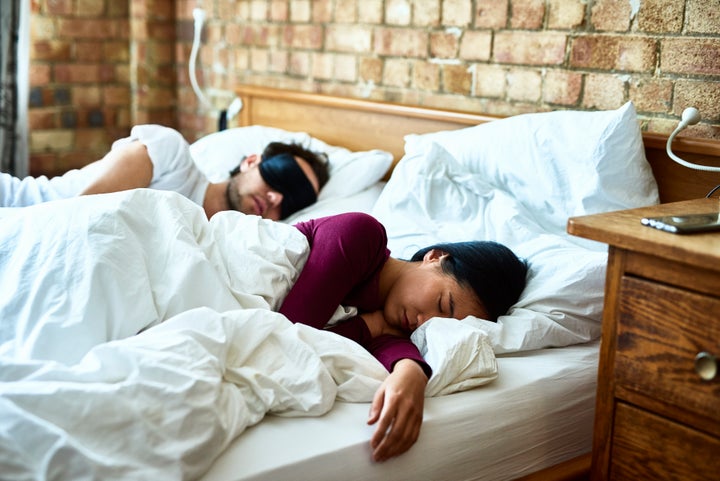You’ve been sleeping on your side for years. Is it possible to switch to sleeping on your back? Or what if you’re an avid back sleeper with a newfound reason to lie in bed on your side? Is making that change doable?
Spoiler alert: It is – in fact, often it’s even necessary. “Our bodies change as we age and so do our sleep needs,” explained Dr. Chris Winter, a double board-certified sleep specialist and Mattress Firm sleep health expert.
If you’re recovering from an injury, for instance, you may need to alter your default sleeping position. Snoring, newly diagnosed sleep apnea and nasal congestion can be other reasons to experiment with switching positions.
“If you or your partner are pregnant, it’s likely you’ll change your sleeping positions over the course of those nine months,” Winter added. This means shifting away from being a default stomach sleeper and avoiding lying on your back in the second trimester and beyond.
Having a new bed partner can also be a catalyst for altering your preferred sleep position. “You may be used to sleeping facing left, but now that would put you face to face with your partner and you don’t want that, so you need to switch to the other side,” Winter said.
According to experts, it’s definitely possible to change how you sleep. It will, however, take some effort. Here’s a look at a few reasons why you may need to switch up your sleeping position and tips from sleep experts on how to do it.
The best sleeping positions for different situations

You probably hop in bed without giving your sleep posture much thought. But there are benefits to different positions that can be helpful to know about:
Side sleeping
“Side sleeping is ideal for back or neck problems, GERD and sleep apnea,” says Dr. David Greenwald, a neurosurgeon and co-founder of Comprehensive MD.
Snorers may also benefit from turning over onto their side. “An adult’s airway is more stable when one sleeps laterally than when you are on your back, and the tongue can slip more easily into a position where it is obstructing the airway,” Winter says.
And the side you typically sleep on can also be dictated by the type of pain you may be in. “For instance, you’d want to prioritise left side sleeping if you have a right shoulder condition – i.e., baseball pitchers never sleep on their throwing arm side,” Winter said.
Winter also noted that there is also some evidence to suggest sleeping on your left side is better for circulation, particularly during pregnancy, “since blood returns to the heart via the right side and the vena cava system.” Michael J. Breus, a clinical psychologist and sleep specialist in Los Angeles, agrees and recommends side sleeping for anyone with high blood pressure or circulatory disorders.
Back sleeping
“Often sleeping on your back relieves pressure points and is orthopedically a bit more stable,” Winter explains. You may want to sleep on your back if you are struggling with shoulder, hip or knee pain, he adds.
Stomach sleeping
“Stomach sleeping works well if you suffer from sleep apnea because your airways are more likely to stay open and you can breathe easier,” Breus says. “The free-fall stomach position, where you lay on your stomach with your hands above a supportive pillow, is the best sleep position for digestive issues like indigestion and heartburn.”
Stomach sleeping, however, can make it difficult to align your spine and Breus warns this can potentially result in muscle and neck pain.
How to switch your regular sleep position

Bedding manufacturers make pillows designed for specific sleeping types, like back, side and stomach sleepers. There are also special pillows to help pregnant women feel comfortable while sleeping on their sides.
Dr. Peter Polos, a sleep medicine specialist and Sleep Number sleep expert, suggests purchasing the pillow to support the type of sleeper you want to be. The right mattress is also key. If you’re a side sleeper, for instance, you’ll need a less firm mattress than for someone who plans to always sleep on their backs.
Additionally, there are specific tricks you can do depending on what position you want.
To learn to sleep on your side, try...
Using a tennis ball: “Side sleep training was traditionally done by taping a tennis ball to the back of the pyjama top,” explains Dr. Georges Ghacibeh, a neurologist with Hackensack University Medical Center’s Institute for Sleep Wake Disorders.
Every time a person turns on their back, the ball pushes against them, making it uncomfortable, so they turn on their side again. Over time, Ghacibeh says, this becomes a trained reflex and may encourage sleeping on the side.
“Often it only takes a few nights of this to get you to avoid the offending position,” adds Dr. Ken Zweig, an internist at Northern Virginia Family Practice Associates. He stresses, however, that we tend to drift back to our natural sleep position over time, so you might need to keep the tennis ball in place for an extended period or repeat the technique every few months or so.
Putting a pillow between your knees: For side sleeping, Polos recommends “sleeping on your side with your knees drawn up slightly towards your chest and/or try placing a pillow between your knees to help your spine property align and to reduce stress on your hips and lower back.”
Using a device: There are special mattresses and devices, such as sleep backpacks and sleep belts, designed to help you sleep in a particular position. “And there are some high-tech wearables, such as the Philips NightBalance, that detect your position, and gently vibrate until you move into the desired position,” Zweig says.
To learn to sleep on your back, try...
Starting out on your back: “For supine sleep training, it’s a matter of trying to fall asleep on your back, then turning back if one wakes on the side,” Ghacibeh explains. Do some deep breathing or a sleep meditation and attempt to feel relaxed in this position, with the hopes of drifting off to sleep like this.
Buying an adjustable bed: Some beds allow you to put your body into specific positions, like zero gravity. By sleeping on an incline, you can make your bed mimic lying back in a recliner chair. Polos said this helps encourage you to sleep on your back, as it provides proper support for your spine to relax in.
Build a pillow buffer: “Use pillows – and lots of them!” says Allison Brager, a neuroscientist involved in the US Army’s Holistic Health and Fitness System. Pillows, she explained, “provide proprioceptive reinforcement to sleep on your side.” They can also help prevent overreaching with an injured shoulder. Zweig says a wedge pillow or two can often help prevent you from rolling over.
For stomach sleeping, prioritise...
The right pillow placement: To make stomach sleeping more comfortable, Polos says to “try placing a soft pillow under your stomach.”
“It’s not too difficult for most people to sleep in a new position for one to two nights, especially if there’s a strong incentive, such as a tennis ball keeping you from your desired position,” Zweig says.
The harder part is teaching your body to keep a new position for the long term. Most people have been sleeping in relatively the same position for years, so adopting a new one can take time and patience. But everyone is different. Some people may pick it up in just a few nights, while others may take a month or more. A lot, Zweig explains, “depends on the type of technique you use to alter your position, how consistent you are at using the technique, and how comfortable you are in the new position.”
